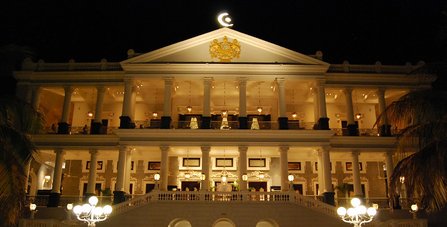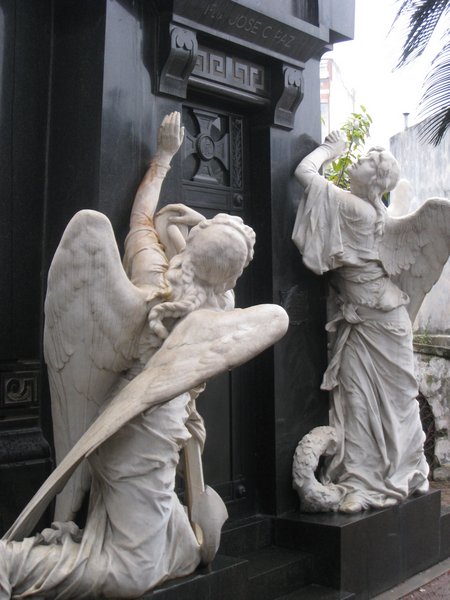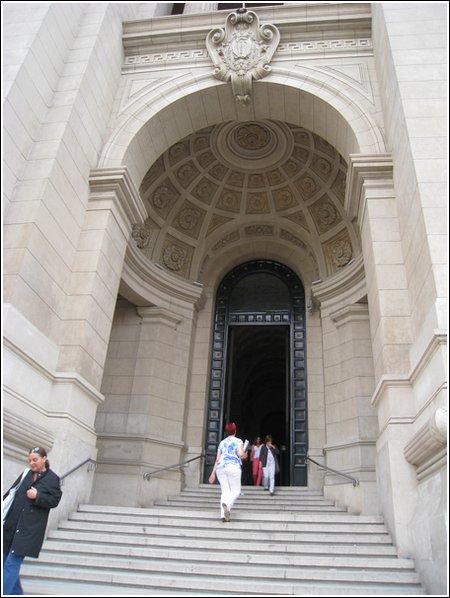With certain exceptions, our travel style involves cheap and cheerful hostels, cozy apartments and hotels at the inexpensive end of the scale. (Our Tripadvisor reviews tend to be biased toward our more expensive experiences, as I haven't reviewed many of the cheaper places.) Yet we've wandered through a few fairly nice hotels, either because they were attractions in themselves or out of pure curiousity. In the unlikely event that I one day try to re-experience this trip with a budget two orders of magnitude greater, these are the places that I'd love to book.
I should note that these are not necessarily the nicest hotels that we know of in any given city, but the best that we've seen on this trip. For example, if I could stay for free at any hotel in London, I'd rather see what the Savoy is like than the Metropolitan. On the other hand, I don't think I've ever been amazed by any hotel so much as I was by the Taj Falaknuma in Hyderabad, where you can quite literally sleep like a prince. For reference, I've included some prices of the nicer, lottery-winner level rooms.
La Mamounia, Marrakech, Morocco (Churchill Suite, ~$2,200/night): Located near the medina (and only a few blocks away from our current apartment), La Mamounia looks less Moroccan and more European than its website suggests. Wandering through its halls, the colonial influence is easy to discern, but this is classic colonial, not a cookie-cutter continenal hotel. In the evening, when the hurrying throngs have whipped up enough dust in the market to inspire previously unknown allergies, La Mamounia is a clear, quiet and clean oasis. We dropped by to try a drink at the Churchill Bar, which was both overpriced and somewhat disappointing: despite displaying several nicer brands of alcohol, a Manhattan with a price tag over $20 was mixed with Four Roses. Setting aside the mediocre drinks, the Churchill and Italian bars are both elegant and comfortable, and I was impressed by the attentiveness and professionalism of the staff. If you're looking for a "low-cost" way to enjoy this location, the Sunday brunch is only about $150. If you try it, tell me how it goes. (That said, we encountered a first for a high-class hotel on this trip: free wifi in public areas.)
The Metropolitan, London, England (Park Suite, ~$1,000): We stopped for a drink at the sister of the Bangkok Metropolitan after picking up our Tanzanian visas from the nearby embassy. Far from the most extravagant hotel in Mayfair, let alone London, it nonetheless has a top-class bar which continues the Metropolitan tradition of knowledgeable and skilled bartenders. Worth it just for a tipple.
The Taj Falaknuma Palace, Hyderabad, India (Grand Presidential Suite, price on request, upwards of $4,350): Pity Nawab Vikar-ul-Umra, who had this palace built in the shape of a scorpion (for astrological reasons), only to realize that he had gone over budget. He ended up giving the palace to Nizam VI, the then-ruler of Hyderabad. The Nizam thoughtfully gave Vikar-ul-Umra the entire amount spent on its construction, saving him from financial catastrophe.
Taj Hotels have leased the palace and converted it into an extravagant fantasy. When we dined here one evening at a family gathering, we were able to watch as one of the guests arrived. A horse-drawn carriage drove him from the gates to the front courtyard. At this point an employee--although courtier seems more accurate--hoisted a gold mace and escorted the new tenant as if he were royalty up the marble steps to reception, as another attendant dropped rose petals before him from an upper balcony. Kitschy, yes, and perhaps they only do this for certain guests, but it fits with the setting. The Grand Presidential Suite, "once the sanctum sanctorum of the Nizam himself," is the most opulent option in a hotel filled with extravagant choices, and features a private pool.

Photo by friends J & J
The Oberoi, Agra, India (Kohinoor Suite, ~$5500): The bar at the Oberoi possesses a unique alchemical secret: it can transform the most staid and ordinary cocktail into one of the best of your life. The Manhattan recipe? Take a standard combination of rye, vermouth and bitters, and serve suffused with scarlet light filtered through tall, ornate windows that frame the sunset-pinked marble of the Taj Mahal. The Oberoi's view of Agra's unquestioned wonder of the world must be seen to be believed, and only hotel guests are allowed to have their drinks served on the balcony.
Unlike La Mamounia, the Oberoi's style speaks more to Agra's mughal heritage than colonial refinement, lightly reminding the visitor that he is elsewhere rather than giving hints of the comforts of home. We didn't get much further than the bar and the opulent lobby, itself an orgy of marble and stone, but supposedly each room has its own view of the Taj Mahal.






